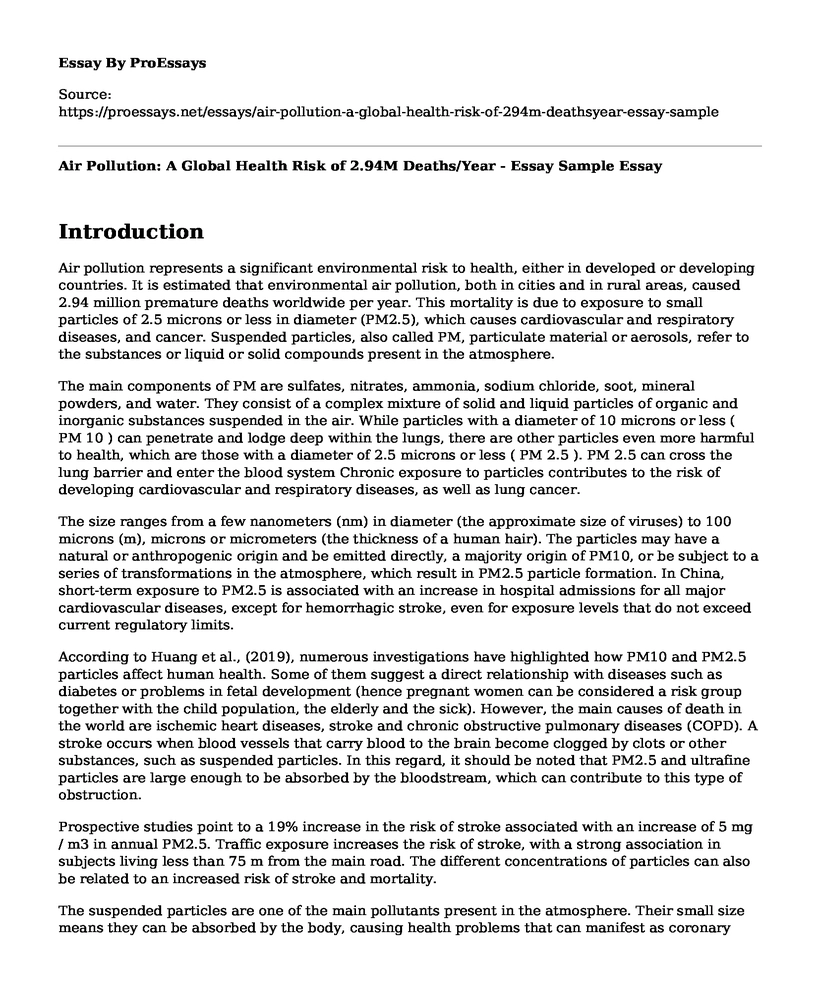Introduction
Air pollution represents a significant environmental risk to health, either in developed or developing countries. It is estimated that environmental air pollution, both in cities and in rural areas, caused 2.94 million premature deaths worldwide per year. This mortality is due to exposure to small particles of 2.5 microns or less in diameter (PM2.5), which causes cardiovascular and respiratory diseases, and cancer. Suspended particles, also called PM, particulate material or aerosols, refer to the substances or liquid or solid compounds present in the atmosphere.
The main components of PM are sulfates, nitrates, ammonia, sodium chloride, soot, mineral powders, and water. They consist of a complex mixture of solid and liquid particles of organic and inorganic substances suspended in the air. While particles with a diameter of 10 microns or less ( PM 10 ) can penetrate and lodge deep within the lungs, there are other particles even more harmful to health, which are those with a diameter of 2.5 microns or less ( PM 2.5 ). PM 2.5 can cross the lung barrier and enter the blood system Chronic exposure to particles contributes to the risk of developing cardiovascular and respiratory diseases, as well as lung cancer.
The size ranges from a few nanometers (nm) in diameter (the approximate size of viruses) to 100 microns (m), microns or micrometers (the thickness of a human hair). The particles may have a natural or anthropogenic origin and be emitted directly, a majority origin of PM10, or be subject to a series of transformations in the atmosphere, which result in PM2.5 particle formation. In China, short-term exposure to PM2.5 is associated with an increase in hospital admissions for all major cardiovascular diseases, except for hemorrhagic stroke, even for exposure levels that do not exceed current regulatory limits.
According to Huang et al., (2019), numerous investigations have highlighted how PM10 and PM2.5 particles affect human health. Some of them suggest a direct relationship with diseases such as diabetes or problems in fetal development (hence pregnant women can be considered a risk group together with the child population, the elderly and the sick). However, the main causes of death in the world are ischemic heart diseases, stroke and chronic obstructive pulmonary diseases (COPD). A stroke occurs when blood vessels that carry blood to the brain become clogged by clots or other substances, such as suspended particles. In this regard, it should be noted that PM2.5 and ultrafine particles are large enough to be absorbed by the bloodstream, which can contribute to this type of obstruction.
Prospective studies point to a 19% increase in the risk of stroke associated with an increase of 5 mg / m3 in annual PM2.5. Traffic exposure increases the risk of stroke, with a strong association in subjects living less than 75 m from the main road. The different concentrations of particles can also be related to an increased risk of stroke and mortality.
The suspended particles are one of the main pollutants present in the atmosphere. Their small size means they can be absorbed by the body, causing health problems that can manifest as coronary obstructions or respiratory failure. Its negative effect is verified even when the concentration is lower than the limit values established in the legislation. The WHO Air Quality Guidelines published in 2005 provide general guidance regarding thresholds and limits for key air pollutants that pose health risks. The Guidelines indicate that by reducing particle pollution (PM 10) from 70 to 20 micrograms per cubic meter (mg / m) it is possible to reduce the number of deaths related to air pollution by 15%.
References
Huang, K., Liang, F., Yang, X., Liu, F., Li, J., Xiao, Q., & Yu, L. (2019). Long term exposure to ambient fine particulate matter and incidence of stroke: a prospective cohort study from the China-PAR project. BMJ, 367, l6720. https://doi.org/10.1136/bmj.l6720
Cite this page
Air Pollution: A Global Health Risk of 2.94M Deaths/Year - Essay Sample. (2023, Mar 27). Retrieved from https://proessays.net/essays/air-pollution-a-global-health-risk-of-294m-deathsyear-essay-sample
If you are the original author of this essay and no longer wish to have it published on the ProEssays website, please click below to request its removal:
- Legislative Approach Taken to Control Waste Water in Trinidad and Tobago and That Taken in South Korea
- The United States Should Advocate for Electric Vehicles and Ban Gasoline Cars
- Multimodal Project Proposal: Destruction of the Environment Paper Example
- Capilano Suspension Bridge and Green Cities Revitalization Paper Example
- Essay Example on Climate Change: A Global Challenge Exacerbated by Human Activity
- Essay Sample on Atmospheric Air Pollution: Global Hazard, Respiratory Illness, Mortality
- The Fisheries Policy - Essay Example







